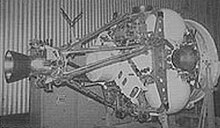Polyot (Russian: Полёт, meaning "flight") was a designation given to two satellites operated by the Soviet Union. Polyot 1 and Polyot 2 were launched on 2 November 1963 and 12 April 1964 respectively.[1] Both spacecrafts were fitted with special controls to allow for maneuverability in space; each was able to adjust inclination as well as apogee and perigee, they were the first satellites capable of such maneuverability.[2][3][4] Each craft weighed 600kg and were launched from Baikonur Cosmodrome by an R-7 rocket.[4] Their orbits have since decayed.[5]

The Polyot satellite designs were later essentially continued under the Kosmos designation starting from Kosmos 185.[6][7]

Anti-Satellite research
editThe Polyot satellites were a part of the Istrebitel Sputnikov Anti-satellite programme, and were designed to test maneuverability capability of remotely operated spacecraft. Once both Satellites were in orbit they were maneuvered to approach one another at a close proximity, the two craft came within 5 km of one another and ship-to-ship radio contact was established, marking a first in spaceflight.[4][6][8]
References
edit- ^ "launchlog". planet4589.org. Retrieved 2024-11-21.
- ^ "Polyot 1". nssdc.gsfc.nasa.gov.
- ^ "Polyot 2". nssdc.gsfc.nasa.gov.
- ^ a b c "The Historic Beginnings Of The Space Arms Race". www.spacewar.com. Retrieved 2024-11-21.
- ^ "Technical details for satellite POLYOT 2". N2YO.com - Real Time Satellite Tracking and Predictions. Retrieved 2024-11-21.
- ^ a b "The historic beginnings of the space arms race". Russia Beyond. 2008-11-01. Retrieved 2024-11-21.
- ^ "MilsatMagazine". www.milsatmagazine.com. Retrieved 2024-11-21.
- ^ "The Hidden History of the Soviet Satellite-Killer". Popular Mechanics. 2013-11-01. Retrieved 2024-11-21.